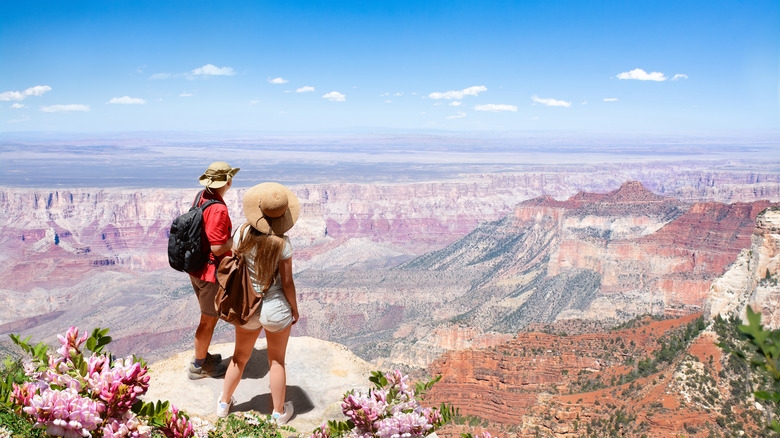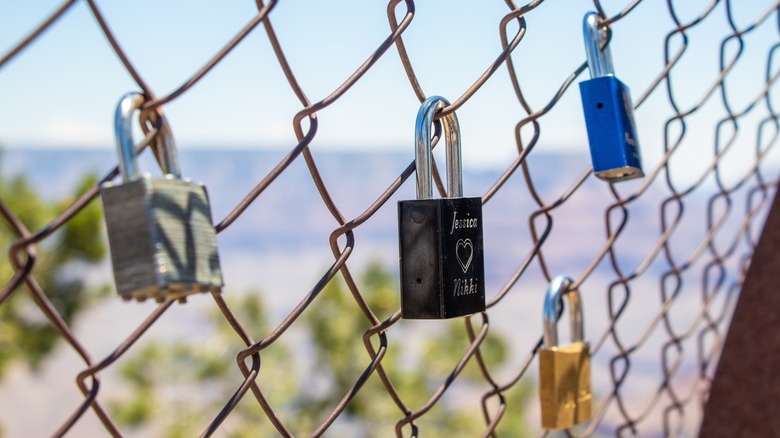The "Romantic Gesture" You Should Really Stop Doing At National Parks
Exploring a new picturesque place with your significant other is one of the most romantic ways to inject passion and quality time into your relationship. To commemorate the moment, you might decide to leave a "love lock" on a bridge or gate, symbolizing your everlasting love. The gesture sounds sweet and harmless, but there can be dire consequences, especially in national parks and other wildlife areas.
If you're not familiar with love locks, the idea is simple: Couples take a padlock, sometimes engraved with their initials or a heartwarming message, and attach it to a bridge, monument, or other structure in touristy areas. They then throw away the key, usually in a nearby body of water, to illustrate their long-lasting commitment to each other.
It's unclear exactly where the custom started — some believe it originated in China, while others pinpoint the 2006 Italian novel "Ho Voglia di Te" by Federico Moccia as the trend's origins. Years later, love locks can still be found in popular hiking and sightseeing spots, but the U.S. National Park Service is taking a stand against the gesture in the hopes of protecting precious wildlife.
Love locks might not be so sweet after all
In an October 2023 Facebook post, the Grand Canyon National Park made a clear request to future visitors: Stop leaving love locks on fences and elsewhere in the park. According to the plea, padlocks are litter and a form of graffiti, and locking them to national park fixtures is akin to leaving behind food wrappers or spray painting the trails. And the main problem isn't even the lock itself — it's the key.
As the post explains, many people toss their keys into the canyon, attracting condors, who are known to ingest shiny objects. If the birds eat too many keys and other metal objects, they can die. To illustrate this point, Grand Canyon National Park attached an X-ray image to the post of a condor with coins trapped in its digestive tract.
Even if you don't intend to leave the key behind on park grounds, love locks still aren't welcome, and rangers will likely remove your lock later using bolt cutters. Similar measures have been taken elsewhere in recent years, including Paris, a hotspot for love locks. In 2015, CNN reported that city workers were removing love locks from the famous Pont des Arts bridge after some of the fencing collapsed due to the weight of the metal. More recently, the city's 18th arrondissement announced it would remove tourists' padlocks, per Forbes.
Other ways to express your love while traveling
Whether you're on your honeymoon, celebrating an anniversary, or just reveling in each other's company, you and your significant other may be tempted to partake in the love lock ritual. But given its impact on the environment and beloved architecture, it's best to forgo the trend, no matter how charming it may seem.
In a 2021 Facebook post, Grand Canyon National Park suggested keeping locks at home and only taking pictures to memorialize your romantic adventure. On that note, don't carve your sweetheart's initials into a tree either. Doing so makes the tree vulnerable to diseases, pests, and even death, per Leave No Trace.
Besides selfies, there are other alternatives to damaging love locks when traveling. Consider organizing a romantic picnic, complete with indulgent snacks and your favorite bubbly beverage (just be sure to tidy up any litter after). Or, look for souvenirs made for couples, such as matching T-shirts or home decor you can both enjoy. These can often be found at rest stops and gift shops in and around the parks. If you travel together often, think outside the box when commemorating your love. For instance, write in a shared journal at each national park you visit or come up with a new relationship vow for every hike you go on. These small rituals might do more for your bond than a love lock ever could.


